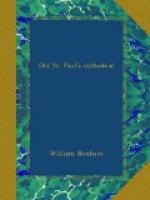There is a painful story in “Foxe’s Martyrs,” that one John Porter was thrown into Newgate by Bonner for thus “expounding,” and that he died there of the ill-treatment he received.
In the short reign of Edward VI., great destruction was wrought in the structure and ornamentation of St. Paul’s, and no thanks are due to the “Protector” that the mischief was not greater. There was no sign for a month or two. Edward ascended the throne on January 28, 1547, and just two months later the French king, Francis I., died. On that occasion, Cranmer, attended by eight bishops, sang a Requiem Mass in Latin at St. Paul’s, and Gardiner preached a funeral sermon before the Lord Mayor and Aldermen, eulogising this persecutor of the Reformed Faith. But now came unmistakable signs of change. Ridley, then Master of Pembroke College, Cambridge, soon to be Bishop of London, preached a somewhat violent sermon at Paul’s Cross against the adoration of saints, the use of holy water, and the reverence done to pictures and images. We may note that on the day of the King’s Coronation, amid all the splendid pageantry and decorations, a cable was fastened to the top of St. Paul’s steeple, the other end attached to an anchor by the Deanery door, and a sailor descended “swift as an arrow from the bow.”
It was in September following that the order from the Council commanded the destruction of images in churches and the discontinuance of all processions. The Bishop, Bonner, protested against the alterations and was sent to the Fleet for contumacy, made submission, and was released after eight days, during which the alterations were made. The images were all pulled down, as were the rood, the crucifix, and its attendants, St. Mary and St. John.
The “Grey Friars Chronicle"[1] (published by the Camden Society), describes all this, and takes care to note that two of the men engaged in the sacrilegious work were killed. The almsboxes shared the general confiscation, and doubtless not only the services of the church, but the poor who came for food, suffered thereby.
Protector Somerset had wide ideas. He aspired to build himself a magnificent palace and to attach a park to it along the banks of the Thames. The palace was on the site of the present Somerset House; the park was to extend from it to St. Paul’s. The cloister and chapel in Pardon Churchyard were destroyed, and five hundred tons of bones were carted away to Finsbury Fields (it is said there were more than a thousand cartloads) and piled up into a mound,




